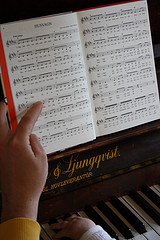Learning piano How To Discover Piano - Sometimes in life, we regret not pursuing hobbies or interests we once enjoyed. I know I regret not continuing to play football and furthering my passion for reading music, especially the piano. Learning to play the piano can seem overwhelming, but when broken down into manageable pieces and with plenty of tuition and practice, it… chords is often the first step for many individuals before embarking on the ABRSM or Trinity exams.
Learning piano chords helps individuals gain a better understanding of the piano’s layout and feel, while also allowing them to play music with melody and meaning. This article provides a more in-depth explanation of piano chords and offers examples of different chord progressions that you can try out yourself.
Let’s take the most common piano chord, C Major. No fancy stuff, just a simple C Major chord. There are typically three positions for this chord: the root position chord, the first inversion chord, and the second inversion chord. The root position chord of C Major consists of C, E, and G (from lowest to highest note). We place our thumb on C, our third finger on E, and our pinky finger on G. For the first inversion chord, we shift our fingers up so that we are playing E, G, and C (in that order). Our thumb is now on E, our third finger on G, and our pinky finger on C—note that this is not the same C as the previous chord; it is the higher octave C, often referred to as “High C.” By playing both the root position and first inversion chords, you can hear the melodic difference. There is also the second inversion chord. Once again, we shift our fingers up, so we are playing G, C, and E (in that order). Our thumb is now on G, our third finger on “High C,” and our pinky finger on “High E.” You can hear the progression from the root position to the second inversion and how it sounds. Once you encounter a piece of music that asks for not just the C Major chord but also the first or second inversions, you will know how to find them easily. This method of “stepping up” applies to all other chords as well.
Another example I can provide is G Major. The root position chords of G Major are G, B, D (from lowest to highest note). The first inversion of this chord is a “step up,” so it becomes B, D, G (from lowest to highest). The second inversion would be D, B, G (from lowest to highest). This approach applies to all other chords, including more complex ones like augmented or diminished chords.
Manuel Marino is a seasoned Senior Producer, Music Composer, and Artist with over a decade of experience. He specializes in branded entertainment across various mediums, including video games, films, and advertising campaigns. With 20+ years as a game music composer, Manuel has worked on numerous platforms, creating diverse orchestral soundtracks. HIRE ME


 Manuel is a passionate, driven, and techsavvy AV technician,
Manuel is a passionate, driven, and techsavvy AV technician, 










